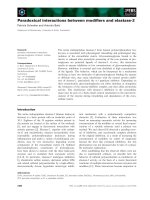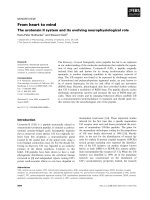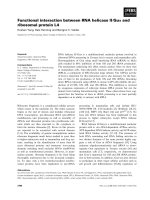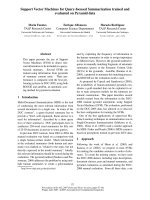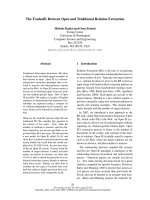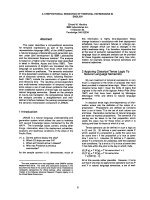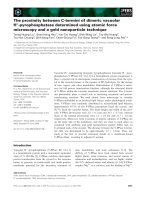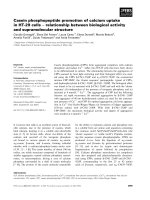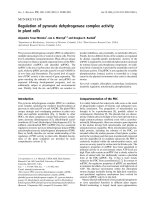Báo cáo khoa hoc:" Genetic relationship between cyclic ovarian activity in heifers and cows and beef traits in males" ppt
Bạn đang xem bản rút gọn của tài liệu. Xem và tải ngay bản đầy đủ của tài liệu tại đây (301.64 KB, 15 trang )
Genet. Sel. Evol. 33 (2001) 273–287 273
© INRA, EDP Sciences, 2001
Original article
Genetic relationship between cyclic
ovarian activity in heifers and cows
and beef traits in males
Marie-Madeleine M
IALON
a
, Gilles R
ENAND
a, ∗
,
Daniel K
RAUSS
b
, François M
ÉNISSIER
a
a
Station de génétique quantitative et appliquée,
Institut national de la recherche agronomique, 78352 Jouy-en-Josas Cedex, France
b
Domaine expérimental de Galle, Institut national de la recherche agronomique,
18520 Avord, France
(Received 19 July 2000; accepted 3 January 2001)
Abstract – Records were collected in an experimental herd over an 11-year period from
purebred Charolais heifers (n = 351), cows (n = 615) and young entire bulls (n = 383).
The objective of the study was to estimate the genetic relationship between the components
of female ovarian activity (age at puberty and postpartum anoestrus length), their growth rate
and body condition score and beef traits measured on related bulls. Two methods were used to
estimate age at puberty and postpartum anoestrus length: the detection of oestrous behaviour
and a test of cyclicity based on plasmatic progesterone assay. This study shows the existence
of significant heritability estimates for the different cyclicity traits (h
2
between 0.11 and 0.38).
Most of the genetic correlation coefficients between ovarian activity and growth rate of females
and males are negative and favourable (r
g
between −0.43 and 0.06). Cyclicity is also favourably
related with body condition score in young or adult females (r
g
between −0.65 and −0.22).
The genetic relationship between female ovarian activity and proportion of adipose tissue in
the male carcass is, however, close to zero. These results show that an antagonism between
male beef traits measured in this study and female ovarian activity is unlikely to be a cause for
concern in the short term.
genetic relationships / ovarian activity / beef-traits / cattle
1. INTRODUCTION
The primary objectives in French beef cattle breeding are to improve growth
rate and production of lean growth. However, knowledge of genetic correlations
between components of merit like female reproduction and male carcass traits
is needed for optimising a multiple trait evaluation in these breeds.
∗
Correspondence and reprints
E-mail:
274 M M. Mialon et al.
Knowledge acquired in other species or between cattle breeds have under-
lined the importance of these correlations within a given breed. A survey
on the correlated responses from several selection experiments mainly on
laboratory animals has been conducted by Scholtz and Roux [19]. From
this survey, it appeared that a selection for body mass or growth rate may have
an adverse effect on viability and reproductive fitness. Such a selection might
give less fertile animals. In the pig, production and reproductive traits have
been considered as genetically independent for a long time. In fact, some
antagonism between the two groups of traits, especially between adiposity
and prolificacy cannot be excluded [7]. Some authors have suggested that
an increase in carcass lean content (by decreasing adiposity) may induce a
deterioration in reproductive performance, because of a deterioration in the
body’s ability for lipid-reserve mobilisation during the gestation or the suckling
period.
In cattle, the comparison of different breeds has shown a slight opposition
between beef and reproductive traits. The faster-gaining breeds with large
mature size do not have a very efficient reproduction. In particular, they
reach puberty at later ages than do slower-gaining breeds with smaller mature
size [5].
Within the French Charolais breed, a favourable genetic relationship has
been revealed between the female growth rate and its ovarian cyclic activity at
puberty and after calving [13,14]. This relationship was consistent with the
published results of three experiments where a selection to increase the heifers’
growth rate until yearling or 18 months did not have an apparent adverse effect
on their age at puberty [2,15,23].
Concerning the relationship between beef and reproductive traits, very little
information is available in the literature. The results of Splan et al. [21],
complementary to the study of MacNeil et al. [10], did not show any relationship
between age at puberty of heifers and beef traits of steers, their paternal half-
sibs. These authors concluded, however, that undesirable links may exist
between carcass traits of males and reproductive traits of females. In the study
of Bergfeld et al. [3], it appeared that selection for a carcass trait such as
deposition of intramuscular fat (marbling) does not have an influence on age at
puberty. Heifers sired by bulls selected for high content of intramuscular fat do
not reach an earlier physiological maturity, as measured by age at puberty, than
heifers sired by bulls selected for lower marbling even if they actually have a
higher marbling.
The objective of our study was to estimate the within breed genetic relation-
ship between the components of female ovarian activity (age at puberty and
length of postpartum anoestrus) and beef traits measured on entire bulls, their
paternal half-sibs.
Cyclicity and beef traits: genetic relationship 275
2. MATERIALS AND METHODS
2.1. Data set
This study deals with three groups of data collected from an INRA experi-
mental herd located in Bourges (Cher) and from two stations of performance
testing:
• ovarian cyclic activity measured on females at puberty or after calving;
• beef traits measured on males;
• selection index of 510 bulls, including the 60 founding sires of the experi-
mental progeny.
2.1.1. Animals
Sires
The experimental animals, generation G
1
males and females, were sired by
a sample of 60 bulls (generation G
0
) chosen by divergent selection among 510
Charolais bulls that were performance tested in two stations for 5 consecutive
years. The 510 bulls entered the stations at a mean age of 312 ± 14 days and
were allowed to adapt to the testing regime for 8 weeks. They were then fed
an equilibrated pellet diet ad libitum during the first 4 testing weeks. Over the
last 14 weeks of the test, distribution was managed individually so as to get an
expected 1500 g · d
−1
average daily gain.
During this period in the station, the bulls were weighed every 28 days for
growth assessment. Feed intake was daily recorded. At the end of the test,
breeding values were computed for final live weight and residual feed intake
and a selection index (I
S
) was used for ranking the bulls. This index was
computed as (Renand, personal communication):
I
S
= 0.426 I
FW
− 0.655 I
RFI
where I
FW
(final weight index) and I
RFI
(residual feed intake index) are stand-
ardised indexes obtained from:
I = 100 + 20
ˆg −
¯
ˆg
σ
p
with
ˆg = predicted breeding value of a bull (contemporary comparison);
¯
ˆg = mean of the predicted breeding values for one station and one year;
σp = phenotypic standard deviation.
In each station-year batch, 6 bulls were selected for progeny testing: three
from each tail end of the distribution of the index (I
S
).
276 M M. Mialon et al.
Females
At the beginning of this experiment between 1985 and 1987, unrelated
Charolais females (breed representative) were bought at weaning on farms in
order to establish the foundation of the experimental herd (generation G
0
).
After rearing, 300 of these females were first mated at two years of age and
subsequently over a period of seven years to the above 60 selected Charolais
bulls. These matings produced 351 G
1
heifers born between 1988 and 1994,
progeny of 192 G
0
dams and the 60 G
0
sires. These 351 heifers were mated at
ages 2 to 5.
Males
Beef traits were measured on 383 young bulls (generation G
1
) born between
1988 and 1994 from 210 G
0
dams and the 60 G
0
sires.
After weaning at 32 weeks of age, the bull calves entered the fattening
station and were allowed to adapt to the testing regime over a period of 4
weeks. During the fattening period, the bulls, divided into groups of 7, were
fed an equilibrated pellet diet ad libitum (0.8 UFV · kg
−1
; UFV: feed unit for
fattening animals). Limited quantities of straw were also placed at the bulls’
disposal.
At the end of the individual control period, the bulls were slaughtered at
either 15 or 19 months of age at the INRA centre of Theix (Puy de Dôme).
The different samples and measures collected at the slaughterhouse allowed the
determination of dressing percentage, the conformation and the composition
of the carcasses. The carcass composition was estimated after the 6th rib had
been dissected and the internal fat deposits weighed [18].
2.1.2. Traits
Age at puberty and the length of the postpartum anoestrus period were
measured by oestrus detection and by the progesterone test as described in
Mialon et al. [12,14]. Females were weighed monthly and body condition
score at 12 months of age and at calving was recorded on a 6-point scale,
according to Agabriel et al. [1]: i.e. from the very thin (0) to the very fat (5).
The traits analysed for the females were:
• For the growing heifer: two estimates of age at puberty: age at the first
observed oestrus (AFO) and age at the first positive progesterone test (AFP),
body weight (BW
12
) and body condition score (BCS
12
) at 12 months of age.
• For the cow at calving: two postpartum intervals: from calving to the first
observed oestrus (ICO) and from calving to the first positive progesterone
test (ICP), body weight (BW
c
) and body condition score (BW
c
) at calving.
Beef traits of males: the traits retained in the present study were the body
weight at slaughter (BWs) and the carcass fat content (FC).
The sire selection index (I
S
) was also taken into account in this study.
Cyclicity and beef traits: genetic relationship 277
2.2. Statistical analysis
2.2.1. Inclusion of the selection of sires
As the 60 founder sires were selected among 510 candidates, the estimation
of genetic parameters may have been biased by a possible modification of
additive genetic variances in comparison with an unselected population [4]. If
the analysis model includes all data upon which selection decisions were based
(I
S
from the 510 bulls in the present study) and if all pedigree information is
taken into account, the estimation of genetic parameters would be unbiased [9,
20,22].
2.2.2. Estimation of genetic parameters
Variance and covariance components were estimated using a restricted
maximum likelihood (REML) procedure applied to a multiple-trait individual
animal model with missing data (some traits were only measured on some
animals) using the VCE 4.0 software developed by Groeneveld [8]. Nine traits
were simultaneously integrated in two successive analyses:
y
1
= sire selection index (I
S
)
y
2
= age at puberty (AFO or AFP)
y
3
= body weight at 12 months (BW
12
)
y
4
= body condition score at 12 months (BCS
12
)
y
5
= postpartum interval (ICO or ICP)
y
6
= body weight at calving (BW
c
)
y
7
= body condition score at calving (BCS
c
)
y
8
= body weight at slaughter (BW
S
)
y
9
= fat content in the carcass (FC).
Up to seven generations were taken into account in the pedigree of founders.
2.2.3. Models
For each group of traits, a specific animal model was used.
The sire selection index was computed for 510 bulls. The linear model
describing I
S
is:
Y
in
= (Station × Year)
i
+ a
n
+ e
in
where
(Station × Year)
i
= interaction between 2 fixed effects: station (2 levels) and
year of control (5 levels)
a
n
= random additive genetic effect of bull n
e
in
= random residual effect
278 M M. Mialon et al.
The heifer traits were measured on the 351 G
1
heifers. The linear model
describing AFO, AFP, BW
12
and BCS
12
is:
Y
ijktn
= Year
i
+ Period
j
+ Dam Age
k
+ Twinning
t
+ a
n
+ e
ijktn
where
Year
i
= fixed effect of year of birth i (7 levels)
Period
j
= fixed effect of the period of birth j (6 levels: end of January,
4 two-week periods in February and March, early April)
Dam Age
k
= fixed effect of dam age k (3 levels: 3–4; 5–6 and 7+ years)
Twinning
t
= fixed effect of type of birth t (2 levels: single or twin)
a
n
= random additive genetic effect of heifer n
e
ijktn
= random residual effect.
The female traits at calving were recorded from 1988 to 1998. A total of
1 802 performances recorded from 289 G
0
and 326 G
1
cows. The average
number of postpartum records per female was 2.9 (1 to 7). The linear model
describing ICO, ICP, BW
c
and BCS
c
is :
Y
ijdln
= Year
i
+Period
j
+Calving difficulty
d
+(Lactation×Age)
l
+c
n
+a
n
+e
ijdln
where
Year
i
= fixed effect of year of calving i (11 levels)
Period
j
= fixed effect of the period of calving j (6 levels:
end of January, 4 two-week periods in February
and March, early April)
Calving difficulty
d
= fixed effect of calving difficulty score (2 levels: natural
parturition, assisted or not, and caesarean delivery)
(Lactation × Age)
l
= interaction between 2 fixed effects: lactation status
(2 levels: suckling or not due to the loss of the calf)
and age (2 levels: primiparous and multiparous)
c
n
= random permanent environmental effect related to cow n
a
n
= random additive genetic effect of cow n
e
ijdln
= random residual effect.
Male traits at slaughter were recorded on 383 G
1
male progeny. The linear
model describing BWs and FC is:
Y
iktn
= Year
i
+ Dam Age
k
+ Twinning
t
+ a
n
+ Final age
iktn
+ e
iktn
where
Year
i
= fixed effect of year of birth i (7 levels)
Dam Age
k
= fixed effect of dam age k (3 levels: 3–4; 5–6 and 7+ years)
Cyclicity and beef traits: genetic relationship 279
Twinning
t
= fixed effect of type of birth t (2 levels: single or twin)
a
n
= random additive genetic effect of bull n
Final age
iktn
= covariate, final age
e
ijktn
= random residual effect.
The model can be written in matrix notation:
y = Xβ + Za + Wc + e
where y is the vector of observations sorted by animals. The dimension of y
is
N
n=1
t
n
t=1
r
nt
where N is the number of animals (sires, females or males)
with measured traits, t
n
the number of traits measured on the animal n (with
1 t
n
6) and r
nt
the number of repeated measures of the trait t on the animal n
with r
nt
= 1 for selection index, heifer puberty traits and male progeny beef
traits and r
nt
7 for cow calving and anoestrus traits.
E
y
a
c
e
=
Xβ
0
0
0
and Var
y
a
c
e
=
V ZG WC R
GZ
G 0 0
CW
0 C 0
R 0 0 R
where: β, a, c and e are vectors of fixed effects, additive genetic effects,
permanent environmental effect and residuals, respectively, and X, Z and W
are incidence matrices relating observations to the above-mentioned vectors.
V = ZGZ
+ WCW
+ R
G = A ⊗ G
0
where A is the relationship matrix and G
0
the 9 × 9 genetic
(co)variance matrix between the 9 traits (⊗ direct product of 2 matrices).
C = I ⊗ C
0
where I is the identity matrix and C
0
the 3 × 3 (co)variance
matrix of permanent environment effects for the three traits measured at calving
(ICO or ICP, BW
c
and BCS
c
).
R =
N
⊕
n=1
R
0n
where N is the number of animals with measured traits, R
0n
the
(co)variance matrix of residual effects for the t
n
traits measured on the animal n
(⊕ direct sum of matrices). There are three different types of R
0n
matrices. For
the 510 sires, R
0n
is a 1 × 1 matrix. For the 640 G
0
and G
1
females, the size
of R
0n
is either 3 × 3 or 6 × 6. For the 383 G
1
males, R
0n
is a 2 × 2 matrix.
The VCE program allows the estimation of the variance and covariance
members of G
0
, C
0
and the three R
0
matrices.
Heritability of the trait t was obtained as follows:
h
2
t
= σ
2
a
t
/
σ
2
a
t
+ σ
2
e
t
for the traits 1 to 4 and 8 to 9
and
h
2
t
= σ
2
a
t
/
σ
2
a
t
+ σ
2
c
t
+ σ
2
e
t
for the traits 5 to 7
280 M M. Mialon et al.
and the genetic correlation between two traits t and t
was obtained as follows:
r
g
tt
= σ
a
tt
/σ
a
t
σ
a
t
.
3. RESULTS
3.1. Environmental influence
The main environmental factors influencing age at puberty and postpartum
anoestrus were described in Mialon et al. [12,14] and will not be repeated here.
The 383 bulls were slaughtered at a mean age of 514 days and a mean weight
of 650 kg. The carcass fat content was 13.7% on average (Tab. I).
The slaughter age logically influenced beef traits of growing animals. The
lengthening of the fattening period by 10 days induced an increase of 10.1 kg
for body weight and 0.08 points for fat content. The BW
S
was significantly
higher (+28 kg) for single born than for twin born bulls. But the type of birth
did not have any effect on carcass fat content. The age of dam influenced the
beef traits of their progeny. The bulls born from younger dams (3–4 years) were
significantly lighter at slaughter (−44 kg) with a higher fat content (+1 point)
than bulls from older dams (7 years and more).
3.2. Genetic variability of the different traits (Tab. II)
The heritability estimates (h
2
± s.e.) obtained in the present study, when
considering the potential selection bias, were all within 1 s.e. of the previously
published estimates obtained without considering this selection bias [13, 14].
The heritability of age at puberty was relatively high: h
2
= 0.28±0.05 for AFP
and h
2
= 0.38 ± 0.04 for AFO. The heritability of the length of postpartum
anoestrus was also important when the trait was based on the progesterone test
(ICP): h
2
= 0.32±0.03. When the length of the anoestrus period was measured
by oestrus detection (ICO), the trait was less heritable: h
2
= 0.11 ± 0.04.
The heritability estimates for the different body weights (BW
12
and BW
c
for the females and BW
S
for the males) were equivalent and higher than 0.50.
Table I. Beef traits of bull calves (n = 383) as influenced by year of birth, twinning,
age of dam and final age.
Mean ± σ
p
Source of variation
Year Single birth / Dam Final age
of birth twinning age (slope /d)
Body weight at slaughter (kg) 650 ± 54 ** +28 kg** ** +1.01 **
Fat content in the carcass (%) 13.7 ± 2.3 ** NS * +0.01**
Cyclicity and beef traits: genetic relationship 281
Table II. Estimates of heritabilities (±s.e.) and genetic correlations (±s.e.) between female reproductive and male carcass traits.
Growing Heifer Cow at Calving Slaughtered Calf Bull
AFP BW
12
BCS
12
ICP BW
c
BCS
c
BW
S
FC
(AFO) (ICO)
Age at First positive AFP 0.28 ± 0.05
Progesterone test (AFO) (0.38 ± 0.04)
(at First Oestrus)
Body Weight at 12 months BW
12
−0.32 ± 0.09 0.53 ± 0.04
(−0.29 ± 0.04)
Body Condition Score at BCS
12
−0.57 ± 0.15 0.33 ± 0.07 0.47 ± 0.05
12 months (−0.65 ± 0.06)
Interval from calving to First ICP 0.43 ± 0.07 −0.20 ± 0.06 −0.41 ± 0.08 0.32 ± 0.03
positive Progesterone test (ICO) (0.58 ± 0.08) (−0.12 ± 0.08) (−0.59 ± 0.09) (0.11 ± 0.04)
(to First Oestrus)
Body Weight at calving BW
c
−0.37 ± 0.07 0.88 ± 0.02 0.33 ± 0.06 −0.26 ± 0.05 0.61 ± 0.04
(−0.31 ± 0.03) (−0.06 ± 0.08)
Body Condition Score at BCS
c
−0.40 ± 0.11 −0.14 ± 0.07 0.77 ± 0.06 −0.22 ± 0.09 0.09 ± 0.07 0.19 ± 0.02
calving (−0.45 ± 0.07) (−0.53 ± 0.11)
Body Weight at slaughter BW
S
−0.43 ± 0.11 0.57 ± 0.09 0.22 ± 0.10 −0.14 ± 0.10 0.53 ± 0.07 −0.21 ± 0.10 0.57 ± 0.03
(−0.25 ± 0.09) (0.06 ± 0.14)
Fat content in carcass FC 0.09 ± 0.10 0.19 ± 0.09 0.31 ± 0.10 −0.13 ± 0.08 −0.06 ± 0.07 0.08 ± 0.08 0.00 ± 0.08 0.43 ± 0.04
(0.08 ± 0.08) (−0.23 ± 0.10)
282 M M. Mialon et al.
For body composition, the heritability estimate of BCS
12
in heifers (h
2
=
0.47 ± 0.05) was close to the estimate obtained for FC in males (0.43 ± 0.04).
On the contrary, the body condition score of cows at calving was much less
heritable (h
2
= 0.19 ± 0.02).
3.3. Genetic relationship among growth rate and body composition
in both sexes (Tab. II)
The heifer growth rate expressed by BW
12
was highly correlated with cow
weight at calving (r
g
= 0.88 ± 0.02). The female weights were also positively
correlated with male body weight (r
g
= 0.57 ± 0.09 for BW
12
and r
g
=
0.53 ± 0.07 for BW
c
).
Body composition was measured using the same method in heifers (BCS
12
)
and cows (BCS
c
). The genetic correlation between these two traits was
relatively high: r
g
= 0.77 ± 0.06. The genetic relationship between heifer
score (BCS
12
) and male fat content (FC) was also positive but moderate
(r
g
= 0.31 ± 0.10). The body condition score of cows was almost genetically
independent of the fat content in males (r
g
= 0.08 ± 0.08).
3.4. Genetic relationship among growth rate, body composition
and ovarian activity in females (Tab. II)
In order to clarify the presentation, we have chosen to discuss the results
where the ovarian activity measure was based on the progesterone assay since
it was less influenced by unidentified environmental factors [13,14]. However,
the correlations related to oestrus traits are also given in parenthesis in Table II.
It should be mentioned that very close genetic correlation coefficients have been
estimated between progesterone and oestrus detection measures: r
g
= 0.94 at
puberty [13] and r
g
= 0.98 after calving [14]. There was also a significant
genetic relationship (r
g
= 0.43 ± 0.07) between the ovarian activity of the
female at puberty (AFP) and after calving (ICP) similarly to the previously
published results [13,14].
The genetic relationship between the ovarian activity measures and BW
showed that a good genetic aptitude for growth until yearling or a high body
weight at calving were moderately associated with an early puberty (r
g
=
−0.32 ± 0.09) or a short postpartum anoestrus period (r
g
= −0.26 ± 0.05).
Age at puberty was also markedly related with body condition score of the heifer
at 12 months (r
g
= −0.57 ± 0.15). High body reserves at calving were only
moderately associated with short postpartum intervals (r
g
= −0.22 ± 0.09).
The genetic relationships between the heifer’s ovarian cyclic activity (AFP)
and the cow’s body traits (BW
c
and BCS
c
) and reciprocally (ICP vs. BW
12
and
BCS
12
) were all negative (from −0.20 to −0.41).
Cyclicity and beef traits: genetic relationship 283
3.5. Genetic relationship among growth rate or body composition
in males and ovarian activity in females (Tab. II)
The genetic relationship between growth rate in the male (BW
S
) and age
at puberty in the heifer (AFP or AFO) was negative: r
g
= −0.43 ± 0.11
with AFP and r
g
= −0.25 ± 0.09 with AFO, respectively. The bulls siring
male calves with high growth rates would also sire female calves with an
early puberty. The relationship between male body weight at slaughter and
postpartum intervals (ICP and ICO) was not significant: r
g
= −0.14 ± 0.10
with ICP and r
g
= 0.06 ± 0.14 with ICO.
The genetic relationship between the young bull carcass composition (FC)
and age at puberty of the heifer was not significant: r
g
= 0.09±0.10 with AFP
and r
g
= 0.08± 0.08 with AFO. The relationship between carcass composition
and postpartum intervals was slightly negative: r
g
= −0.13 ± 0.08 with ICP
and r
g
= −0.23 ± 0.10 with ICO.
4. DISCUSSION
The present study is based on information collected as part of a large-scale
experiment aimed at quantifying the genetic relationships between beef traits
and other traits of merit, like female maternal traits, in the Charolais breed. To
reach a compromise between limited experimental facilities and good precision
of the estimated parameters, it was necessary to optimise the choice of the
founder sires. Instead of a random sampling, it appeared more efficient to
make a selection of the bulls in order to increase the genetic variability of the
components related to muscular growth. The genetic parameters estimated
from data measured on the selected bulls progeny might however be biased
because of a modification of the variability as compared to an unselected
population. The bias might be more important for traits highly correlated with
the selection criteria. An appropriate model including all data upon which
selection decisions were based allows to avoid this bias [9,20,22]. In our
situation, the parameters estimated from female data were not very different
whether sire selection was taken into account or not. However, the precision
of the estimated genetic parameters was increased (lower s.e.).
The heritability of age at puberty was relatively high when appreciated by
age at first oestrus or age at first positive progesterone test. These results
were consistent with previously published estimates [11]. The postpartum
interval to first positive progesterone test was also a relatively heritable trait
(h
2
= 0.32). An estimate of the same magnitude was obtained by Darwash
et al. [6] in dairy cattle. The negative favourable relationship between female
growth rate or body condition and her ovarian activity previously described by
Mialon et al. [13, 14] was confirmed in the present study. A genetic aptitude
284 M M. Mialon et al.
for high growth rate or important body fat deposits is related to an efficient
cyclic ovarian activity. The favourable correlation between growth rate and
ovarian activity at puberty is consistent with the results from some selection
experiments [2,15,23] where selection to improve heifer growth rate did not
have any adverse effect on age at puberty. Although the estimated coefficient
is only moderate, the genetic relationship between heavy weight or important
body fat deposits at calving and short postpartum anoestrus is an original piece
of information. Up to now, only phenotypic relationship has been underlined
in several surveys without quantifying, however, the genetic and environmental
contributions.
The most important aspect of the present study was the opportunity to
quantify the genetic relationship between male beef traits and two components
of the female reproduction: age at puberty and postpartum anoestrus length.
In order to improve the productivity of beef cattle herds, it is necessary to
reduce the unproductive periods in the reproductive life of a cow, i.e. reducing
age at first calving and/or reaching the production objective of one calf per
cow per year. Breed comparisons show a possible opposition between beef
and reproductive traits. Selection realised in France tends to intensify the beef
specialisation in the Charolais breed by breeding bulls with high muscular
growth rate and low fat content. This selection of bulls, based on a selection
index combining final weight and feed efficacy at the end of an individual
performance-testing period, is actually efficient for improving growth and
slaughter traits. The observed selection response estimated for the 60 founder
sires of the present experiment was an increase of+14 kg in muscle weight
simultaneously to a decrease of −5 kg of fat content [17].
The genetic relationship between male and female growth rate is positive
with correlation coefficients higher than +0.50. This indicates that genetic
determinism is partly common for male and female growth rate. So it is
not very surprising that male growth rate and female ovarian activity were
favourably correlated since this was already the case between female growth
rate and her ovarian activity. The relationship of male growth capacity is more
marked with age at puberty (r
g
= −0.43) than with postpartum anoestrus
(r
g
= −0.14). In the study of Splan et al. [21], age at puberty in heifers
and carcass weight in males were genetically independent (r
g
= +0.06). The
results of the present study show that a selection that aims to increase male
growth rate might not have adverse consequences on postpartum anoestrus
length in cows and even might be favourable to decrease the age at puberty of
heifers.
Although age at puberty and postpartum interval were negatively related to
the female body condition score, no significant genetic correlation was found
with the male carcass composition. Certainly, this lack of relationship was a
consequence of the rather poor genetic correlations found between the male
Cyclicity and beef traits: genetic relationship 285
and both measures of female fatness (r
g
= +0.31 and r
g
= +0.08). Male
fatness was measured by a partial dissection of carcasses of animals that were
intensively fed in a fattening system that enhanced differences in muscle and
fat deposit growth. At twelve months of age, heifer fatness was scored by
manual appreciation. Heifers were fed a roughage diet in a rearing system
where differences were certainly highly dependent on feed intake capacity.
Fatness of cows at calving was also scored but it was no more related to
growth. Differences in fatness were certainly primarily dependent to feed
intake capacity of roughage, to maintenance costs or residual feed efficiency.
It appears that the appreciation of adipose tissue importance in the male,
heifer or cow were three different traits more or less correlated due to the
different components involved.
Although weak, these relationships between fat in the male and female are
nevertheless positive. For this, it should be questioned whether an intensive
selection to decrease carcass fat content of male calves might have adverse
consequences on female ovarian activity. This does not seem to be the case
in the present study. The genetic relationship between fat content in males
and cyclic ovarian activity in the female is almost zero: slightly negative with
postpartum interval and slightly positive with age at puberty. In the study
by Splan et al. [21] there was also independence between age at puberty and
proportion of adipose tissue in the carcass. In the same way, a selection to
increase the ability to marble did not influence age at which puberty is attained
in heifer progeny [3]. These results show that further selection on muscle
growth capacity in a specialised beef breed does not seem to constitute a real
threat for female ovarian activity. However, a limit in the decrease of fat
content might be imposed by the consumers, if some sensorial meat qualities,
like flavour or juiciness are influenced by the proportion of lipids in muscle.
5. CONCLUSION
This study allowed to confirm genetic parameters previously estimated. Age
at puberty and length of postpartum anoestrus are relatively heritable traits with
a mean heritability of 0.27 and are related positively. The ovarian activity of
a female at a given age is also favourably related to her body weight and the
amount of body fat stores.
The study of the genetic relationship between ovarian activity in females
at puberty or after calving and beef traits in males shows that an antagonism
between these two groups of traits is unlikely to be a cause for concern in
the short term. A selection to increase growth rate of males after weaning
and during fattening will have some favourable response in the reduction of
anoestrus periods of the growing heifer or the suckling cow. A selection against
fatty carcasses in males won’t have a significant response on the ovarian activity
286 M M. Mialon et al.
in females. It is, however, also necessary to make sure that beef traits in males
are not unfavourably related with other breeding ability traits of the females
such as fertility.
ACKNOWLEDGEMENTS
The authors wish to thank the staff at the INRA experimental herd of Galles
for help with oestrus detection, blood sampling and data collection, A. Neau
for writing the relevant computer programmes used in data collection, the staff
of the INRA Laboratory of hormonal assays (Nouzilly) for performing proges-
terone assays and W. Brand-Williams for English revision of the manuscript.
REFERENCES
[1] Agabriel J., Giraud J.M., Petit M., Détermination et utilisation de la note d’état
d’engraissement en élevage allaitant, Bull. Tech. CRZV Theix INRA 66 (1986)
43–50.
[2] Archer J.A., Arthur P.F., Parnell P.F., van de Ven R.J., Effect of divergent selection
for yearling growth rate on female reproductive performance in Angus cattle,
Livest. Prod. Sci. 57 (1998) 33–40.
[3] Bergfeld E.G.M., Rasby R.J., Nielsen M.K., Kinder J.E., Heifers sired by bulls
with either high or low expected progeny differences (EPD
S
) for marbling do not
differ in age at puberty, Anim. Reprod. Sci. 40 (1995) 253–259.
[4] Bulmer M.G., The effect of selection on genetic variability, Amer. Nat. 105
(1971) 201–211.
[5] Cundiff L.V., Gregory K.E., Koch R.M., Dickerson G.E., Genetic diversity among
cattle breeds and its use to increase beef production efficiency in a temperate
environment, in: Proceedings 3rd World Congress on Genetics Applied to
Livestock Production, 1986, Lincoln, NE 9, pp. 271–282.
[6] Darwash A.O., Lamming G.E., Woolliams J.A., Estimation of genetic variation
in the interval from calving to post partum ovulation of dairy cows, J. Dairy Sci.
80 (1997) 1227–1234.
[7] Ducos A., Bidanel J.P., Genetic correlations between production and reproductive
traits measured on the farm, in the Large White and French Landrace pig breeds,
J. Anim. Breed. Genet 113 (1996) 493–504.
[8] Groeneveld E., User’s guide and reference manual. Instituteof Animal Husbandry
and Animal Behaviour, Mariensee, 1997.
[9] Henderson C.R., Best linear unbiased estimation and prediction under a selection
model, Biometrics 31 (1975) 423–447.
[10] MacNeil M.D., Cundiff L.V., Dinkel C.A., Koch R.M., Genetic correlations
among sex-limited traits in beef cattle, J. Anim. Sci. 58 (1984) 1171–1180.
[11] Martin L.C., Brinks J.S., Bourdon R.M., Cundiff L.V., Genetic effects on beef
heifer puberty and subsequent reproduction, J. Anim. Sci. 70 (1992) 4006–4017.
Cyclicity and beef traits: genetic relationship 287
[12] Mialon M.M., Renand G., Krauss D., Ménissier F., Puberty of Charolais heifers
in relation to growth rate. 1. Phenotypic variability, Ann. Zootech. 48 (1999)
413–426.
[13] Mialon M.M., Renand G., Krauss D., Ménissier F., Puberty of Charolais heifers in
relation to growth rate. 2. Genetic variability, Ann. Zootech. 48 (1999) 427–434.
[14] Mialon M.M., Renand G., Krauss D., Ménissier F., Genetic variability of the
length of postpartum anoestrus in Charolais cows and its relationship with age
at puberty, Genet. Sel. Evol. 32 (2000) 403–414.
[15] Morris C.A., Baker R.L., Hunter J.C., Correlated responses to selection for
yearling or 18-month weight in Angus and Hereford cattle, Livest. Prod. Sci. 30
(1992) 33–52.
[16] Renand G., Mise en place du Vachotron II, in: Séminaire Planification Expéri-
mentale en Génétique Animaleà St Martin de Ré, 1996, INRA, Paris pp. 123–134.
[17] Renand G., Fouilloux M.N., Ménissier F., Genetic improvement of beef produc-
tion traits by performance testing beef bulls in France, in: Proceeding of the 6th
World Congress on Genetics Applied to Livestock Production, Vol. 23, 1998,
Armidale, pp. 77–80.
[18] Robelin J., Geay Y., Estimation de la composition de la carcasse des taurillons à
partir de la composition de la 6
e
côte, Bull. Tech. CRVZ Theix, INRA 22 (1975)
41–44.
[19] Scholtz M.M., Roux C.Z., Correlated responses to selection for growth, size and
efficiency. In: Hofmeyr J.H. and Meyer E.H.H. (Eds.), in: Proceedings of the
2nd World Congress on Sheep and Beef Cattle Breeding, April 1984, Pretoria,
South Africa, pp. 433–443.
[20] Sorensen D.A., Kennedy B.W., Estimation of genetic variances from unselected
and selected populations, J. Anim. Sci. 59 (1984) 1213–1223.
[21] Splan R.K., Cundiff L.V., van Vleck L.D., Genetic parameters for sex-specific
traits in beef cattle, J. Anim. Sci. 76 (1998) 2272–2278.
[22] van der Werf J.H.J., de Boer I.J.M., Estimation of additive genetic variance when
base populations are selected, J. Anim. Sci. 68 (1990) 3124–3132.
[23] Wolfe M.W., Stumpf T.T., Wolfe P.L., Day M.L., Koch R.M., Kinder J.E., Effect
of selection for growth traits on age and weight at puberty in bovine females, J.
Anim. Sci. 68 (1990) 1595–1602.
To access this journal on line:
www.edpsciences.org

